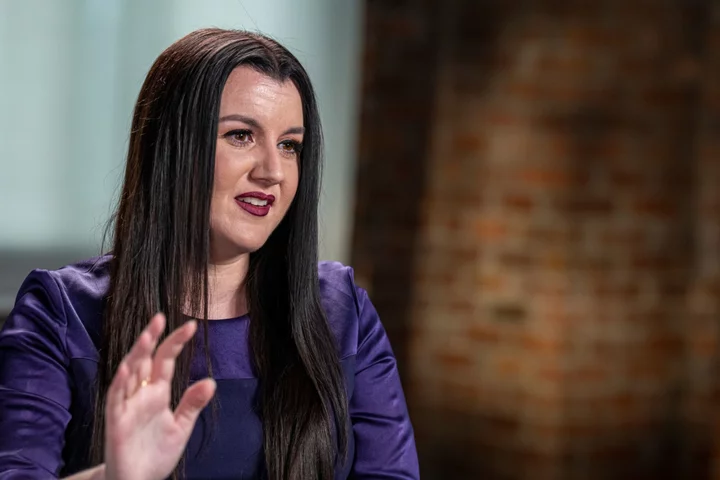Online grocery startup Instacart has been flirting with an initial public offering for years and is finally set to take the plunge Monday in another bellwether listing for a still-anxious market.
Instacart, officially Maplebear Inc., is seeking to raise as much as $660 million Monday at a valuation of more than $9 billion and begin trading Tuesday.
The San Francisco company is striking while the iron is hot, on the heels of Arm Holdings Plc lodging the year’s biggest IPO and then rising 25% in its trading debut last week. Shares of the chip designer, still 90% owned by SoftBank Group Corp., slipped Friday but remained up almost 20% above the offer price.
If Instacart trades well, it will add momentum for other listings. Boston-based marketing and automation startup Klaviyo Inc., which is expected to price its IPO Tuesday, decided on Sunday to boost its target for the listing to $557 million, Bloomberg News reported. German footwear maker Birkenstock Holding Ltd. is also preparing to go public within weeks.
Taking its cue from Arm, Instacart is taking the safe route by lining up big investors to support its listing. It’s brought on PepsiCo Inc., one of its partners, to participate in the deal.
Cornerstone Investors
It’s also enlisted Norway’s Norges Bank, TCV, Sequoia, D1 Capital Partners LP and Valiant Capital Management as cornerstone investors that could take up to 60% of the shares, according to its prospectus.
That’s several times more than what’s generally seen in IPOs, setting up Instacart to benefit from a scarcity of available shares when its stock begins trading.
Founded in 2012, Instacart was a pioneer in online grocery delivery and rose to high-flier status with a $39 billion valuation during the coronavirus pandemic, when it became a household name with shoppers stuck at home. But as the virus waned and investors factored in higher interest rates and a potential recession, Instacart struggled. It slashed its internal valuation three times last year, the last time to about $13 billion in October.
On Friday, Instacart elevated its target for the IPO to $26 to $28 a share. That could value the company at $9.3 billion to $9.9 billion based on the fully diluted equity listed in its filings.
Simo’s Pivot
Chief Executive Officer Fidji Simo, who replaced co-founder Apoorva Mehta in 2021, has tried to reshape the business by pivoting to advertising and technology over grocery delivery, taking advantage of the voluminous amount of consumer data it collects to help grocery stores boost sales.
Instacart turned a profit in the first half of the year, matching the IPO candidate profile now favored by investors who have grown disillusioned with money-losing growth companies.
The company had net income of $242 million for the first half, compared with a loss of $74 million for the same period last year. Its revenue grew 31% to about $1.5 billion during the six months ended June 30, aided by supercharged growth in its higher-margin ad segment, the second-biggest revenue contributor after the core grocery delivery service.
Instacart is also now wrangling more profit from each order. Net income grew as a percentage of gross transaction value, with a profit of 1.5% in 2022 replacing a loss of 0.3% in 2021.
Sustainable Growth?
Whether that growth can be sustained — especially with orders flat in the first half — is a key question for investors.
“The grocery business is not a high margin business,” said Don Short, head of venture equity at InvestX Capital, a late-stage investor in Instacart. “It is a very, very tough, very competitive business and if times get tougher, people are going to weigh on the one hand, do I use Instacart? Or do I just stop on the way home from work and pick something up?”
That wouldn’t leave much of a margin to work with if Instacart’s business remained merely an add-on cost to grocery delivery, Short said.
“I think them establishing themselves as a delivery channel, allowing things like product placement, marketing partnerships with consumer packaged goods companies, opens up a lot more options for Instacart as a company,” he said.
Uber, DoorDash
Yet, grocery chains that have partnered with Instacart for its delivery channel and access to app users are building out their own ecommerce and last-mile delivery capabilities, not to mention increased spending on commissions to other delivery platforms like Uber Technologies Inc. and DoorDash Inc.
Instacart’s ability to continue convincing retailers, consumer brands and suppliers that it’s a viable digital partner and platform where ad dollars can be spent will largely depend on user retention and order growth on its app, and by extension how well it translates its understanding of shopping patterns into product placement.
Short sees PepsiCo’s investment as legitimizing the pivot under Simo. Since she joined Instacart from Meta Platform Inc.’s Facebook, the company’s brand partners have roughly doubled to more than 5,500.
Instacart’s IPO is being led by Goldman Sachs Group Inc. and JPMorgan Chase & Co., with Bank of America Corp., Barclays Plc and Citigroup Inc. also participating along with 15 other underwriters. Instacart’s shares are set to trade on the Nasdaq Global Select Market under the symbol CART.
In addition to giving a retail investors a chance to invest, the listing will give Instacart’s current investors, which include the likes of Andreessen Horowitz, Tiger Global Management and Coatue Management, an opportunity to cash out at a time when exits for late-stage startups have been few and far between.
--With assistance from Amy Or, Bailey Lipschultz and Katie Roof.

